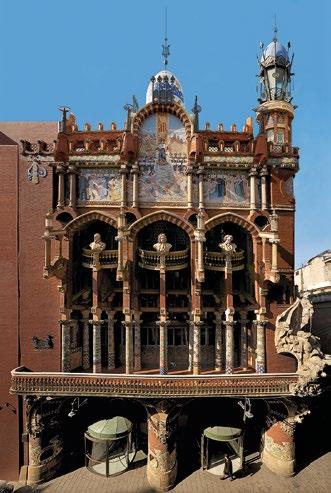Guided tours Palau de la Música Catalana



The Palau de la Música Catalana was built between 1905 and 1908 by the Modernist architect Lluís Domènech i Montaner as the seat of the Orfeó Catalá, financed by subscription funds from the public. The building is situated in the Sant Pere quarter, one of the most popular areas of Barcelona. An architectural jewel of Catalan Modernism, it is the only concert hall listed as a World Heritage Site by UNESCO (1997) and it is now an essential meeting point for the country’s cultural and social life. It has also become a sentimental symbol for the heritage of an entire population, who identify it with their history. The Palau currently holds more than 600 concerts each year, with a total of 670,000 people attending the concerts and enjoying the guided tours.

As if the Palau were a ship in the middle of the old quarter of Barcelona, the sculpture of Saint George constitutes its figurehead and is surrounded by figures and symbols from Catalan popular culture. Together with the characteristic colourful former box office windows, they make the façade impossible to photograph. Do you accept the challenge?

The Palau Café is situated in the Modernist foyer of the Palau de la Música Catalana, a unique space that offers breakfasts, appetisers, quick meals, afternoon snacks, etc. Savour your visit to the Palau in a space surrounded by Modernist décor or on the charming outdoor terrace, where you can enjoy your food in a unique setting in the heart of Barcelona.

This room has been a meeting point for music and society since the beginning of the 20th century. It incorporates all the materials emblematic of Modernism: wrought iron, tiles, mosaics, glass and wood, not forgetting the impressive 300-kg chandelier hanging from the ceiling. Search for all these details and marvel too at the columns representing nature on the balcony, each one with its own unique decoration and colours.



1.
The composer Josep Anselm Clavé was a key figure in Catalan popular music and in the social drive behind choral singing. His best-known work, Les flors de maig, envelops his bust in a sculpture to the left of the stage.

2.
The majestic organ made by the Walcker company has more than 3,700 pipes. Since 1908 the king of instruments has issued forth a sound that hypnotises visitors. Let yourself be carried away by its melodies and by the captivating beauty of the Concert Hall.

To the right, Ludwig van Beethoven contemplates the century-long history of concerts at the Palau with Wagner’s Ride of the Valkyries above his head. The Palau is a temple to the universality of music and the stage for the world’s finest orchestras, performers and repertoires.

If the Palau is a Modernist celebration of nature, the skylight symbolises the Sun, which illuminates everything. Surrounded by the faces of 40 singers it represents the centrality of choral music, with an ecstasy of colours that fall like a drop of honey onto the audience. This icon of the Palau, and of the entire city of Barcelona, possesses a visual magnetism that is impossible to resist.

Did you know that there are more than 2,000 sculpted roses in the different spaces in the Palau? There is no need to count them, just look for them in the columns, ceilings, stained-glass windows and even on the floor. Now you know why the Palau is also referred to as the “stone garden”.

6.
The Palau is a glass box in which natural light plays to magical effect. The projection of colours from the side walls and the ceiling make visiting the Palau a unique experience. Light, garlands of flowers and the colours of the stained-glass flood the only Modernist concert hall in the world with natural light.

7.
The eighteen muses surrounding the stage have amazed and inspired generations of musicians. With eighteen instruments from different parts of the world, they represent music without frontiers. They form a sculptural group of stone, mosaic and trencadís (small pieces of broken tiles), which was the masterpiece of Eusebi Arnau and Llúis Bru. Come and fall under their spell!

Visit us!
Guided tours, audio-guided tours, self-guided tours with a booklet... There are also Premium packages: a visit with a photo shoot, drawing workshops, an escape room and so much more!
For more information, prices, availability and tickets, visit www.visits.palaumusica.cat
Follow us: @palaumusicacat
L3: Plaça Catalunya
Palau de la Música Catalana
Ticket Box Office
c/ Palau de la Música, 4-6 08003 Barcelona Tel: (+34) 93 855 57 31 visites@palaumusica.cat
www.palaumusica.cat
L1: Plaça Catalunya/Urquinaona
L4: Urquinaona
Bus turístic City Tour